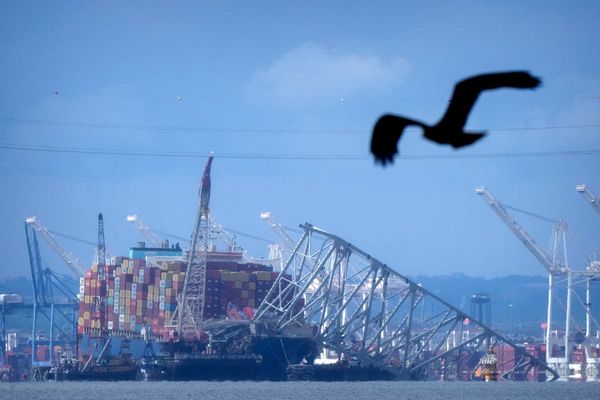
In a rehearsal space at Birmingham Royal Ballet’s headquarters, two dancers are trying to perfect a piece. Soloist Riku Ito is clutching a rubber roll that he’s pretending is a guitar while Javier Rojas circles around, gliding, spinning and sliding through Ito’s legs. “Too soon, Javi!” calls out choreographer Pontus Lidberg. “You need to wait for the high note: da-da-da-da-da-da-DA! And Riku, stop crossing over. You won’t remember that many movements.”
The music they are dancing to is an acoustic guitar piece called Laguna Sunrise, beefed up from its original arrangement with strings and what sounds like mandolin by the composer Christopher Austin. It’s not one of his original works, though: it’s by Black Sabbath, from their otherwise crushingly heavy 1972 album Vol 4 (the one that leaned so heavily on narcotics that it thanked “the great COKE-Cola company of Los Angeles” in its credits). This sequence will duly appear in the third act of Black Sabbath: The Ballet, almost certainly the first time any of metal’s founding fathers have had a major dance company pay tribute to their work in a full-length show.
“I don’t know much about Black Sabbath,” says a writer from another newspaper who is sitting next to me. “Is it this melodic on the record?” Yes, I say – for I am here not as ballet critic but as heavy metal writer. They often had acoustic instrumentals on their albums, I explain. “Ah! How interesting.”

It’s all a great joy for Tony Iommi, Sabbath’s 75-year-old guitarist. What would he have thought 50 years ago, had someone suggested a ballet be constructed around his music? “I’d never have believed it,” he says. “Especially remembering how we were looked on when we first started: no one wanted to know.”
In those days, Sabbath were considered the lumpen proles of rock, and not only by the guardians of high culture. Rolling Stone said of their music: “It continues to sound like nothing so much as a fleet of tanks in its death agony.” NME reckoned they were “about as subtle as an enraged mule kicking down a stable door”. Let It Rock was even less complimentary. They were, writer Max Bell offered, “a monumental bore”.
Orthodoxies change: for years now, Sabbath have been considered one of the most important groups in rock history, the fathers of heavy metal. Nevertheless, news of the ballet came as something of a surprise earlier this year. It’s not that Sabbath had never been approached about unusual projects before. Back in the 1970s, Iommi says, Ken Russell suggested an opera based around their songs. “We just went, ‘Eh?’ I thought it was weird – and I would have thought this was weird back then.” But now, with the band increasingly honoured in their Birmingham hometown (there’s a Black Sabbath bridge near Centenary Square) the time feels right.

The idea came from the company’s director, Carlos Acosta, who saw Sabbath as the ideal subject for the second in a trilogy of shows celebrating Birmingham. While others try to persuade me that Acosta is a diehard Sabbath fan, he’s a little more careful. He’s Cuban, and Sabbath meant nothing to him as a kid because rock’n’roll was taboo, he explains. But he understands what they represented.
“I’m working class – I am Black Sabbath. I’m trying to do the same things Black Sabbath achieved. The essence is the same. I understand why the music means so much to the fans, and why they crave it and how relevant they are. War Pigs, man, that’s the story of humanity right now.” He’s referring to the antiwar anthem on Sabbath’s second album Paranoid – with the most famously lazy opening rhyme in rock history: “Generals gather in their masses / Just like witches at black masses.”
Black Sabbath: The Ballet isn’t a straight narrative telling of the story of the band, nor is it a sequence of dances to their greatest hits. It’s a three-act show, with three different choreographers, that pulls together its threads in the final act. At times there are voiceovers – Iommi and Sharon Osbourne, wife of singer Ozzy, have both been interviewed for it – but the soundtrack is a continuous piece of music. One might think Sabbath wouldn’t lend themselves to the variety of tones and textures needed for ballet, but that wasn’t the case, Austin says.

“I had to revisit a whole load of music I hadn’t actively listened to for a very long time. The big surprise for me was that, beyond the superfamous headline tracks, there was a richness and variety to the songs, and also a huge amount of lyrical music. I realised quickly that the ballet was totally possible, because the catalogue is so rich. In a way, there’s too much to choose from.”
Nevertheless, Sabbath are associated with a particular sound – that being Iommi’s downtuned electric guitar, a sound forced on him by circumstance. At 17, he lost the tips of the middle and ring fingers of his right hand in an industrial accident, and to continue playing guitar he needed to first make false fingertips from an old Fairy Liquid bottle, then to loosen his strings, creating the distinctive doomy, downtuned rumble of the classic Sabbath albums.
Although the orchestra will be supplemented by rock band instrumentation, Austin still had to find a way to capture that tone. “Sabbath is not just guitar, bass and drums – it’s more than that, because of the downtuning. There’s a long and dare I say ugly tradition of taking amazing music, doing arrangements for it, and turning it into music for Ceefax pages. That’s not what this is about. It’s about honouring the rawness, the irregularity of the music. The structures of Sabbath songs are incredible.”

Iommi has been happy with what he’s heard. “Chris came over to my house and played me his ideas. It was great to see someone else’s impression of what we did. I was wondering how they would do it – would they just play our songs as we did them? And of course they don’t. There are little parts of us, then an interlude, then back in with another riff. I’ve heard loads of different versions of our music – accordions, everything. You name it, I’ve heard it. But this is really great.”
It sounds as though it was more of a challenge for Lidberg and the choreographers. “I grew up with classical music,” says Lidberg. “Heavy metal was not the soundtrack of my life. But I think any meeting between seemingly very disparate things is a good idea.” Lidberg didn’t want simply to slap classical choreography on top of rock music. But nor did he simply want to recreate the cliches of rock music in ballet form. He has worked with the dances to make them “more like a dialogue, where I give an impetus and see what happens. I don’t give super-specific movements, I give ideas and let the dancers respond. I see how it resonates in their bodies and from there give further instructions.”

Although the true test will come on opening night, there’s a palpable sense of excitement in and around the Birmingham Royal Ballet. The eight hometown performances are sold out, as are five of the six at Sadler’s Wells in London, with a few tickets left for three of the four Plymouth shows. Most gratifyingly for Acosta, more than two-thirds of tickets have been sold to new visitors. “It’s the most successful show we’ve ever had,” he says, “a show that didn’t exist when we sold the tickets. This is just one of many things we’re bringing into the repertoire, but as so long as we keep connecting, that’s what I want. I want a company that is energetic, that is dynamic, that is not yesterday, that is now.”
Will any of the first-time visitors – most of them metalheads rather than ballet fans – return? “We’re working very hard to retain as many of them as we can,” Acosta says. “But even if it’s 100 people out of the thousands, that’s still a big success. So let’s see.”
• Michael Hann is the author of Denim and Leather: The Rise and Fall of the New Wave of British Heavy Metal
• Black Sabbath: The Ballet is at Birmingham Hippodrome, from 23 to 30 September; Theatre Royal Plymouth, 12-14 October and Sadler’s Wells, London, 18-21 October







